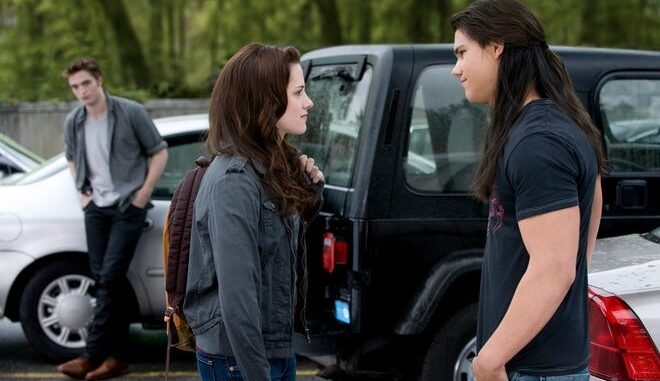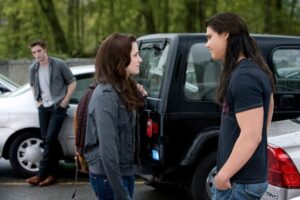
‘Twilight’ and the love that dares not speak its shame
This is a story about shame.
All across the country, there were women who managed to avoid Stephenie Meyer’s series about a star-crossed human/vampire teen couple. (Vampire Edward lusts for mortal Bella, but also for her blood; the books are less plot than endless yearning). They resisted the first three books — refused to read them, didn’t know they existed — and the lunacy that was “Breaking Dawn.”
“Twilight” came for the tweens, then for the moms of tweens, then for the co-workers who started wearing those ridiculous Team Jacob shirts, and the resisters said nothing, because they thought “Twilight” could not come for them. They were too literary. They didn’t do vampires. They were feminists.Then something happened: the release of the “Twilight” movie, which last year introduced $384 million worth of audience members to Kristen Stewart as mortal Bella and Pattinson as lust incarnate.

“Prior to ‘Twilight,’ my favorite books were by Anthony Burgess” and Ayn Rand, says Jenny West, 32, who had never heard of the series until she saw ads for the movie last year. “I bought ‘Twilight’ (the book) with the full intention of ripping it apart.” Then she read it. In one night. Bought “New Moon” the next day. “I was kind of horrified with myself, and I had to keep going.” When she finished the last book, she reopened the first one and started again.
She founded the blog Twitarded, to process what had happened to her. She and co-Twitard Debbie Connelly were last spotted soliciting donations to win a charity benefit date with Peter Facinelli, the actor who plays Edward’s dad.
People, be warned. “New Moon,” the “Twilight” movie sequel, opens on Friday. Everyone is vulnerable.
One minute you’re a functioning member of society, the next you’re succumbing to the dark side, wondering how deep you’re willing to go — and what that longing says about you.In “Twilight,” Edward Cullen waffled between wooing and eating new girl Bella Swan. He chose love. In “New Moon,” the darkest installment of the series, Edward becomes convinced that his girlfriend would be safer without him, so he dumps her to protect her and then vanishes. Bella, catatonic from the pain, finds solace in Jacob Black, the devoted friend who has just learned he is a werewolf, and their relationship grows deeper, and this description is utterly, utterly useless because none of it gets at what the “Twilight” series is actually about, which is being 17.

It’s a time capsule to the breathless period when the world could literally end depending on whether your lab partner touched your hand, when every conversation was so agonizing and so thrilling (and the border between the two emotions was so thin), and your heart was bigger and more delicate than it is now, and everything was just so much more.“I noticed in that first week of reading that I was feeling things I hadn’t been able to feel in a long time,” says Lauren Ashlock, 27. She’d avoided the “Twilight” series ever since the 2005 release of the first book, because when she saw the passion of so-called TwiHards, she thought, Wackos.
She relented last year only because she wanted to be an informed hater. She snuck the books into her house, at first reading them in the bathroom so her husband wouldn’t laugh. The floodgates opened. “I’d locked away a lot of emotions,” she says. “I’d numbed out.” It had been a terrible year, with unrelenting job stress, and yet suddenly she was feeling alive again.
The behavior that followed will make perfect sense to someone who has read “Twilight” and seem bat-crazy to anyone who hasn’t: Ashlock got three dogs and named them after “New Moon’s” werewolf pack. She and her husband traveled to Forks, the two-bit town in Washington state where Bella and Edward fictionally live. When the Ashlocks have a child, they will name it from the novels: “If it’s a girl her middle name will be Renesmee, and I don’t care if you hate the name because I love it.”
